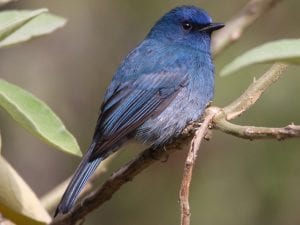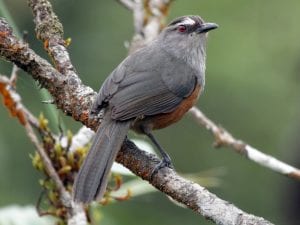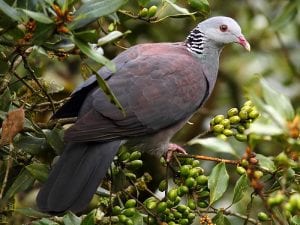
How Nilgiris' tea, exotic plantations are warding off its endemic Shola birds

Shrinking Shola grasslands, coupled with its replacement by tea plantations, eucalyptus and wattle and increasing human habitation have all led to a huge drop in the number of bird species in the Western Ghats, a report has revealed.
The first of its kind ‘State of India’s Birds 2020’ report, released on Tuesday (February 18), has pointed towards a steep decline in the number of bird species visiting the Western Ghats over the past two decades.
Out of 867 species it assessed, the report has listed key species of all states, that fall within the Western Ghats range, which needs ‘most conservation concern’.
Species that need attention
A total of 19 species have been identified for Tamil Nadu. They are Nilgiri Laughingthrush, Nilgiri Pipit, Nilgiri Sholakilli, Ashambu Laughingthrush, Kashmir Flycatcher, Indian Vulture, White-naped Tit, Yellow-throated Bulbul, White-rumped Vulture, Forest Wagtail, Red-headed Vulture, Red-necked Falcon, Gull-billed Tern, Pacific Golden Plover, Cinnamon Bittern, Nilgiri Thrush, Nilgiri Wood Pigeon, Broad-tailed Grassbird, and White-bellied Sholakilli.
Of 19 key species, eight are endemic to the Westen Ghats. They are the Nilgiri Laughingthrush, Nilgiri Pipit, Nilgiri Sholakilli, Ashambu Laughingthrush, Nilgiri Thrush, Nilgiri Wood Pigeon, Broad-tailed Grassbird, and White-bellied Sholakilli.
“The 12 Western Ghats endemics included in this analysis are almost 75 per cent lower in their abundance index today than before 2000, indicating a steep long-term decline”, the report revealed.
Related news: How encroachment of water bodies is endangering aquatic birds, avian guests
The Nilgiri pipit, Nilgiri sholakilli, Nilgiri laughingthrush, Ashambu laughingthrush, Palani laughingthrush, Nilgiri thrush, White-bellied Sholakilli, Nilgiri flycatcher, Black and Orange flycatcher, Broad-tailed Grassbird, Golden-headed Cisticola and Nilgiri Wood pigeon are forms the list.

To come to a definite conclusion, the data is either deficient or uncertain for all the bird species barring the Nilgiri pipit.
Shrinking habitat
These 12 bird species are dependent on shola forests or shola grasslands, found in the Western Ghats. The scientific community has categorised these shola birds as ‘sky island birds’. The sky islands are successive mountains separated by valleys.
“Sky island ecosystems face a number of threats, placing many of these endemic species at risk. Over the past century, shola grasslands in the central and the southern Western Ghats have been extensively replaced by tea plantations and stands of exotic species like eucalyptus and wattle, leaving very little habitat for grassland specialist species,” said the report.
According to VV Robin, an expert in sky island bird species, the lack of historical data, especially the systematically collected ones come in the way of securing the correct picture, which reflects in eBird, an online database of bird observations.
“This is particularly true of the highly diverse areas like the Shola sky islands. Some of these areas are mountaintops where very few explorations were conducted. Some species such as White-bellied and Rufous-bellied Sholakilli, found in the report, do not have sufficient data for analysis,” he said.
Related news: Chasing cheetahs: A conservation effort or misplaced priority?
In 2000, if one had collated all records of these species, it would not have amounted to more than 100 records. This is the challenge we are dealing with, he added.

“Today, with millions of eBird records from India pouring in, we hope things will change. This may happen in some areas for some species. However, that is not the case when it comes to Shola sky islands. Even today, when our team examined the eBird records, we found several records that didn’t cover major areas but just those close to the roads,” said Robin.
M Mathivanan, coordinator of ATREE’s Agasthyamalai Community Conservation Centre, Tirunelveli attributed the expanding human habitats as the cause for declining Shola grasslands in those forests.
“Besides human habitation, plantations like eucalyptus has become a threat for shola forests as they won’t allow other plants to grow. There are also studies which show that the eucalyptus affects the groundwater table, on account of which there is a ban on such plantations in the Kolar and Bellary regions of Karnataka” he said.
Speaking to The Federal, Ashwin Viswanathan, research associate, Education and Public Engagement, Nature Conservation Foundation (NCF) pointed to the report not assigning reasons for the decline of bird, except in a few cases.
“We hope that the report will encourage people to find out the reason,” he said.
When asked about the effect of data deficiency and uncertainty in numbers of other Western Ghat species, he said inadequate numbers didn’t aid in calculating the numbers.

“We need a large amount of data to arrive at a conclusion. For some species, we have limited data. For some other species, there are data but there are fluctuations and errors. So we termed them as uncertain” said Viswanathan.
Related news: How tea brews trouble for parties in the Nilgiris
Ecologist Godwin Vasanth Bosco, who works on Shola grasslands restoration in Nilgiris district said more than 80 per cent of grasslands have disappeared due to tea and exotic plantations. The effect was not only on birds but also on tribals who are dependent on grasslands for pastoral activities, he added.
“We are making restoration efforts in central Nilgiris and parts of Kotagiri. Connecting the restored patches with the already existing ones is a great challenge. The tribals are now slowly turning to take up chemical-intensive farming” said Bosco.


